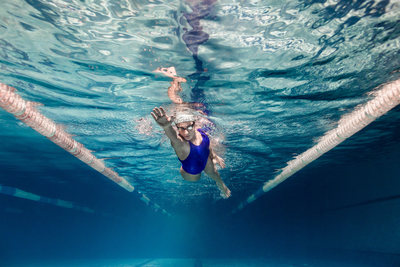Here’s something you may not know: there are thousands of recycled swimwear options in the fashion sphere. There are so many in fact, we at Everyday Recycler think there’s no reason to buy swimsuits made from virgin plastic ever again. So why not embrace a more sustainable summer and get on board with recycled swimmers.
Swimwear has traditionally been made from synthetic materials like nylon, polyester, and spandex. But over the last ten years, a number of recycled fabrics have been developed that use recycled nylon or polyester. Many sustainable swimwear brands have now incorporated these eco-friendly fabrics into their designs.
These recycled swimwear fabrics behave just like traditional fabric, but they help clean up the planet. If you want to jump straight into the fun stuff, then head on over to check out our articles:
Otherwise, ready to read on about swimwear?

A Brief History of Swimwear
The concept of swimsuits was invented in the mid-1800s. Before that, most people (especially men) usually bathed naked. But swimsuits became more prevalent around the mid-1800s, as recreational activities became more accessible thanks to the growth of the railroad and other means of transport. People were now able to get to locations like the beach far more easily.
At the time, the main purpose of swimwear was to hide the human body, and particularly, the female body. Early swimsuits for women were far more different than what we consider swimwear now – e.g. a belted dress was worn with stockings and bloomers or pants.

And during this same period in the mid-1800s, men were banned from bathing in the nude, not without some uproar, of course!
Early swim costumes for men were shoulder to knee one-piece bathers, with a small skirt for modesty. For both men and women, these early swimsuits were made from heavy materials such as flannel, wool, or even hessian (or burlap). The fabrics became heavy when wet and could make it difficult to swim.
It wasn’t until 1896, when swimming became an Olympic sport, that design flaws were finally addressed. More streamlined and lighter swimsuits were developed. Into the early 1900s and beyond, swimwear for both men and women also became more form-fitting and less restrictive, with shorter lengths and sleeves removed.
And in some cases they even became attractive!
What is Swimwear Made From?
As we mentioned above, early swimsuits were made from materials like flannel or wool. These fabrics would become heavy with water making it difficult to swim.
Fortunately, as designs started to change during the early to mid-1900s, so too did the fabrics. New fabrics were designed with properties better for the form-hugging swimsuits being developed – and closer to what we see today. Fabrics like nylon and latex were used early, and polyester, spandex, and other blended fabrics were introduced a little later.
Let’s go over some of the key materials:
Nylon
Nylon (also referred to as a polyamide) is a plastic polymer where amide bonds link monomers. (See what is plastic to learn more). Although nylon is generally considered a synthetic or human-made polyamide, there are naturally occurring ones like wool or silk.
Nylon is durable and absorbs moisture but does not retain it, making it perfect for tight hugging clothes. It’s stretchy, soft, and doesn’t crease. As well as clothing nylon is used in many everyday objects like rope, thread, fishnets, drapes, combs, and of course stockings and tights.
Polyester
Polyester is also a man-made plastic. It is made by polymerization of ethylene glycol and terephthalic acid. It is basically the same material as PET or polyethylene terephthalate, the plastic used to make plastic water bottles. Polyester is durable and moisture-absorbing like nylon, plus it retains its shape, is colorfast, and can resist sweat and UV rays.
Polyester is commonly used in fashion, activewear, and outerwear such as coats and anoraks. It is also used in textiles like soft furnishings or bedding, duvets, and even footwear.

Spandex
Spandex is another synthetic fiber, a polymer with the base material of polyurethane. It is also referred to as Lycra or elastane. Spandex can be stretched to 5 to 8 times its size – ideal for swimming and movement.
Spandex is often blended with other materials to improve their stretch. It is commonly used in activewear, leggings, skinny jeans, or underwear and socks.
Elastic
Swimwear edges are often given additional support with elastic strips. Elastic is usually made from either rubber or latex but may use spandex. The rubber or latex is woven with polyester, cotton, or nylon to hold it together.
Other fabrics
Other materials are used to make swimsuits, including neoprene, velvet, cotton crochet, other knitted fabrics, and mesh. You can also find swimsuits made using natural fibers like cotton. However, they are often lined with polyester or nylon.
Why Use Recycled Fabrics
As we covered above, most swimsuits or swim trunks are made from plastic. Plastic -as I’m sure all of you know – is something we have too much of right now, with too much unable to be recycled.
Textile waste is challenging for us to address, but it’s an area we need to get better at, and here’s why:
- Almost 17 million tons of textiles are generated each year in the United States alone.
- Only 15% is recycled, which means more than 11 million tons ends up in landfill.
- Clothing production is continuing to grow too. The average consumer buys 60% more pieces of garment compared to 15 years ago. Each clothing item is now also kept only half as long.
It’s true buying recycled swimwear will not solve all of these issues. But, every small step helps. Using recycled materials in place of raw materials will reduce the amount of plastic waste produced. It also sends a message to the fashion industry that we want change.
There’s another reason we should support swimwear brands using recycled fabric. Many of these companies are aligned with other sustainable and ethical practices. They are making an effort to reduce their brands’ impact through waterless dyeing, sustainable packaging, reduced carbon footprints, and transparent and ethical manufacturing – and our support helps their effort grow.
Besides, with so many great recycled swimwear options available, why not choose recycled?

Recycled Swimwear Fabrics
Let’s dig a little deeper into recycled swimwear fabrics.
Traditionally, the nylon, polyester, and spandex used to make our swimsuits have been made from virgin resources. The majority of these fabrics are produced at chemical plants using either coal or petroleum resources.
But nowadays, there are better options. There are recycled nylon swimwear fabrics like Econyl® or EcoLux TM or fabrics made from recycled plastic bottles (PET) like Repreve®. Here are the top three eco-friendly swimwear fabrics used for swimsuits.
Aquafil’s Econyl® is regenerated nylon made from discarded fishing nets, fabric scraps, carpet flooring, and industrial plastic. The waste is sorted and cleaned, to save as much of the nylon as possible. The nylon is recycled back into its original form, the same as virgin nylon.
Designers fashion the recycled nylon into new products like swimsuits and we get to enjoy them. Once they reach their end of life, the cycle can begin again.
Another recycled swimwear fabric is Repreve® by Unifi. This is polyester made from recycled plastic bottles and often referred to as recycled PET or rPET. Plastic bottles are made from plastic number 1 or PET, the same plastic used to make polyester. Repreve is created by Unifi, and so far, they have recycled over 20 billion plastic bottles.
Econyl and Repreve are both used regularly to make activewear, and you can learn more with our other blog post: Recycled Leggings! Yoga Challenge Accepted!.
EcoLux
EcoLux was created by Vitamin A and it is a recycled fabric made from reclaimed nylon fiber waste. EcoLux is a blend of Repreve recycled nylon and Xtra Life Lycra. The Xtra Life Lycra helps the fabric keep its shape longer, hopefully giving the swimwear a longer life. A similar blend is used by the brand Summersalt.
Looking After Your Swimwear
Believe it or not, part of my motivation to write this post was due to a recent experience.
The other day, I went to put my bathers on. As I pulled them on, the elastic stretched but didn’t stretch back – and suddenly, my once-snug bathing suit was loose and sagging around the important bits!
I’m sure you’ve had this happen too, and this is just one of the many reasons we should take good care of our swimwear. A lot of effort and resources have gone into making the garment.
Helping our garments live the longest possible life is a fantastic way we can reduce our impact. So, whether your swimsuit is made from recycled fabrics or not, here are some key tips for taking care of it:
- Remove saltwater and chlorine as soon as possible after use, by rinsing in water before you head home.
- Gently handwash your swimsuit in cold water, without too much scrubbing. Hot water will damage the fabrics.
- Line dry your swimsuit in the shade (to minimize fading), or better still, lay your swimsuit out on a flat surface to save it from stretching.
We can also do a few things that will help reduce the risk of microfibres from our swimsuits. Microfibres are tiny fibers that are released from synthetic or plastic fabrics when they are washed. Every time you wash your clothes, hundreds of thousands of microfibers can be released.
To reduce the risk of microfibres, washing by hand in cold water is shown to reduce the number of microfibres released. You can also get filters to capture a percentage of the microfibers.
But that’s definitely a topic for another post.
Recycling Your Old Swimwear
Most swimsuits, including recycled swimwear, are made with a blended fabric making them more difficult to recycle.
While some new techniques are being developed to help separate the different fibers, we’ll have to do our best to make our suits last as long as possible.
For clothes and textiles not suitable for reuse, including swimsuits – they can be recycled (or down-cycled) into other items. They can be turned into rags, shredded into shoddy, or used for padding in car seats.
Below are a few options for how to dispose of your old swimwear:
Swimwear Brands – Contact the company you purchased it from to see if they have a recycling program or recommend other options. Brands that use Econyl, for example, may take your swimwear back when it’s worn out. The fabric can be sent back to Aquafil and recycled.
Charities – If your swimwear is in good condition, then try donating it to charity.
Reformation – Uses Thredup. Customers can send wearable or end-of-life products to them, and they will sort and recycle them appropriately.
H&M – Will take back your old garments, including swimwear in store.
Patagonia – Patagonia will take back clothing through their Worn Wear program.
Upparel (was Manrags) – sell socks and recycle socks and have now expanded into a clothing recycling program. They will even pick up clothing from your door. Available in Australia only.
Buying a New Swimsuits
Now that you have all the information at hand, here are some questions to ask yourself the next time you might want to buy a swimsuit.
Questions to start off with:
- Do you really need another swimsuit?
- How many swimsuits do you need?
- Is your old swimsuit still wearable?
- Can you get a second-hand one?
Now let’s get to the exciting bit. Head over to our articles
Or head to our Recycled Brand Directory to Recycled Store to find the brands making eco-friendly swimwear from recycled fabric.
The Wrap Up
Here’s our wrap-up.
- Almost all swimwear is made out of synthetic materials.
- But many companies are transitioning to using eco-friendly swimwear fabrics made from recycled nylon or polyester.
- Not only are they helping rid the world of plastic waste, they’re also creating something useful.
- There are different types of recycled swimwear fabric available, with some made from recycled polyester and some made from recycled nylon.
In fact, there are so many different types of recycled swimwear no-one should ever need to buy virgin plastic swimwear – just find the perfect suit for you.
- Written by MasterClass, 2019, 28 Types of Fabrics and Their Uses
- Econyl®, the process
- Discover Repreve
- Polyester and Polyamide, Baselayer.co.uk
- Textiles: Material-Specific Data, United States Environmental Protection Agency
- UNECE, 2018, UN Partnership on Sustainable Fashion and The SDG’s
- MessyNessy, 2014, Victorian Prudes and their Bizarre Beachside Bathing Machines














